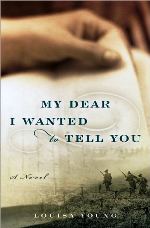Author Louisa Young discusses her World War I-era love story, My Dear I Wanted to Tell You in today's interview.
 Q: What inspired you to write My Dear I Wanted to Tell You?
Q: What inspired you to write My Dear I Wanted to Tell You?
A: My grandmother, Kathleen Scott, was a sculptor, and during World War One she worked briefly casting the faces of wounded men, to help surgeons who were trying to rebuild their damaged faces. I wrote her biography years ago, and came across photographs, drawings and diagrams of those early years of maxillofacial surgery which have never left me. The courage of the doctors on one side and the damaged young men on the other seemed to me quite extraordinary, and yet, in wartime, in a war on that scale, it was not extraordinary, it was quite every day. So how do human beings cope with that? How do we deal with what is unbearable? Also, like most people, I am secretly fascinated by the strange line where the miraculous and the disgusting meet.
Q: Can you tell us a little bit about your creative process?
A: I read a lot, I try to write, sometimes I succeed. I tend not to know why. I may write nothing for weeks on end, and get more and more frustrated, and then I remember that this is part of the process, and write like a mad thing for a few months. I do dream of writerly solitude, and love it when I achieve it, but then I get lonely.
Q: Are there any authors/prominent figures who influence your work?
A: Everyone I've ever read. Or nobody. It depends on my mood. I can't name particular people though. It always suggests you're comparing yourself to them, which can make you sound a bit of a prat.
Q: Where did you come across the field postcard from which the book takes its title?
A: I saw it in an exhibition at the Wellcome Collection in London. When a soldier was injured, it might take a while for news to get home, either via the official telegram, or in a letter which would have to go through the censors. These pre-printed tick-the-box multiple choice postcards were available at field hospitals and could go directly. I saw it in the display case, and found it touching, sitting there, pristine, nearly a hundred years later. I felt sorry for it, that its purpose had never been fulfilled --- but then its purpose would have been a sad one. It seemed to hold an untold story --- what story? I imagined having to fill in a card like this --- the circumstances under which it would come about --- and that became the first scene that I wrote:
"Riley at the casualty clearing station. I thought: you'd lie. Of course you would. What are you going to say? 'My Dear Mum, I have been badly wounded in the balls?' Of course not... Also, it echoed what everyone always says about their soldier dad or granddad or uncle or brother: 'Oh, he never talked about it, after the war was over'. I bet they wanted to, some of them. They must have wanted to. The men in the photographs from the Queen's Hospital seemed to me to be desperate to talk."
Q: What kind of research did you undertake when coming up with the plot? Are any of the events based on a true story?
A: I read everything in sight, and stole all kinds of true things for this story. My grandmother appears, Major Gillies is real, and the Queen's Hospital at Sidcup, its barber and the cigarette girl, the houses on Bayswater Road (I grew up in one of them). And there was a patient who did what Riley Purefoy does to Nadine, though we're not told what became of them in the long run. I've tried to keep the history accurate.
Q: Many people are profoundly moved when reading the novel. Which part was the hardest to write?
A: None. It came naturally. I did make myself cry quite often. I don't find that hard though.
Q: Do you have any personal connection to the events depicted?
A: Yes, a great deal.
Q: What does the future hold for Louisa Young?
A: I'm writing a sequel now, about Riley, Nadine, Rose, Julia and Peter in their forties, and their children, and the coming of World War Two. It brings in Nadine's family across Europe. The book is doing what it wants, which I like. The characters are real to me now; they do what they do, and I don't have to push them around. It's much easier. They generate their own chaos, and their own patterns within it. There's going to be some more books after these two. 1918 is done, 1938 I'm working on, and I foresee 1943, 1952, 1965, 1976 --- then I'll regret not having written 1928, 1936, 1948, 1959... I think I may be writing the twentieth century, through these families. Or at least these families through the


